Sony VAIO SE: An IPS Laptop for Under a Grand
by Jarred Walton on April 3, 2012 5:40 PM ESTDouble Your Pleasure with a Sheet Battery
Battery life is good, which isn’t too surprising as Sandy Bridge laptops with switchable graphics have always delivered the goods. The wrinkle here is if you want to get the $150 sheet battery, you can double your battery life. As mentioned earlier, Sony also has some intelligent battery circuitry so that you’ll discharge/charge the sheet battery first, allowing you to put it away (or connect it to the separate charging station) and take the now lighter laptop with you.
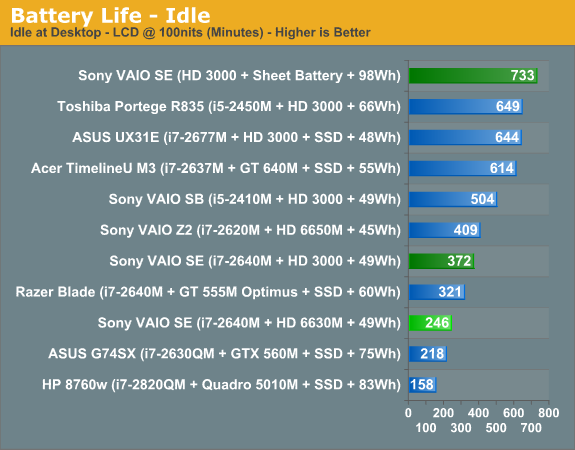
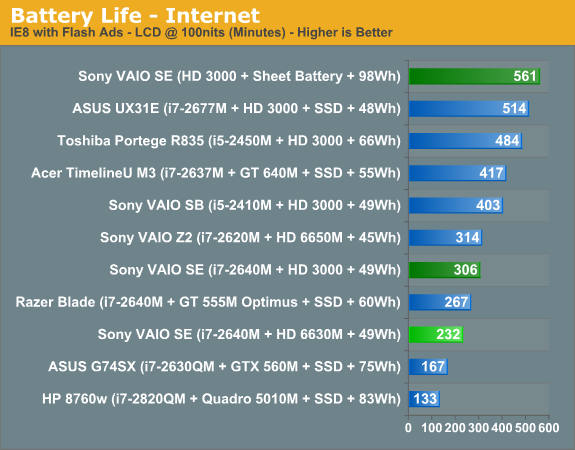
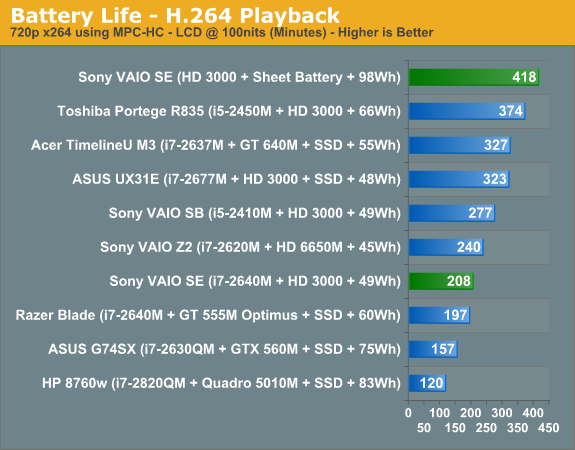

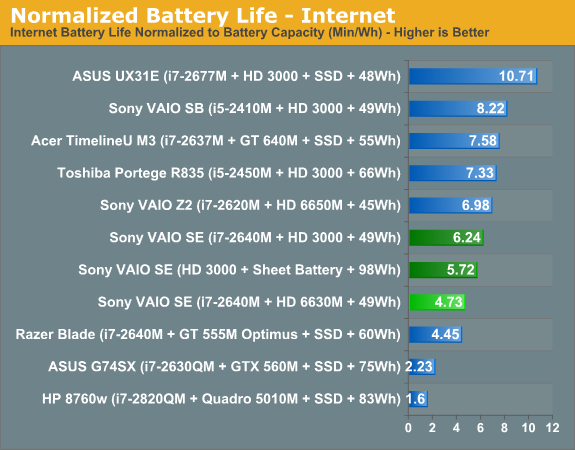
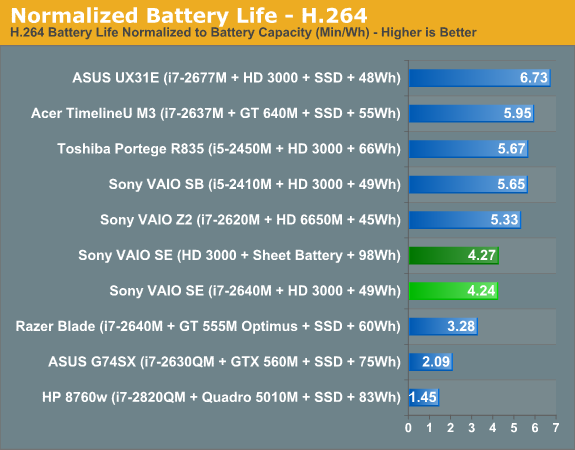
If we take the stock scores, battery life is similar to what we’ve come to expect from Sandy Bridge laptops. The integrated 49Wh battery actually delivers better battery life than some competing laptops with 56Wh batteries, but we’d take the reported battery capacity with a grain of salt as there’s certainly some wiggle room there. Even so, our normalized battery life charts show that Sony knows a thing or two about power optimizations. As for the sheet battery, it does more or less double the battery life—there’s some margin for error in our battery life tests and given the number of battery tests we already had to run we didn’t repeat most tests multiple times.
We also did a quick test of idle and Internet battery life with the discrete GPU enabled, just to see how much extra power that consumes. Based on the 49Wh battery capacity, the VAIO SE idles at around 7.75W and averages 9.41W during the Internet test while running off the IGP. Turn on the HD 6630M and idle power draw (on battery) increases to 11.71W while Internet power draw is 12.42W. Based on that it appears the HD 6630M has an idle power draw that’s around 4W more than the HD 3000, but for “typical” Internet use it only uses 3W more than the IGP.
We also tested dGPU battery life while playing games and still managed two hours of gaming with the main battery, but that was using the Balanced power profile with AMD’s PowerPlay set to Maximum Battery Life. Using those settings, we found that typical gaming performance dropped anywhere from 3% (Battlefield 3) to as much as 40% (Skyrim), with most titles showing a drop in frame rates of around 15-20%. Set PowerPlay to Maximum Performance and you’ll get full performance from the HD 6630M at the cost of battery life; our 122 minute result became 90 minutes with PowerPlay at Max Performance. Double that with the sheet battery, though, and you’re looking at roughly three hours of decent gaming performance while unplugged—something you’re not likely to exceed right now with any “gaming” laptop!
Thermals: Too Hot to Handle?
We mentioned earlier that we have concerns with the way the hinge and LCD pivot down to block the sole exhaust port on the back of the laptop. We never experienced any instability from the design, but one look at thermals under load should help you understand why we think the design is flawed:
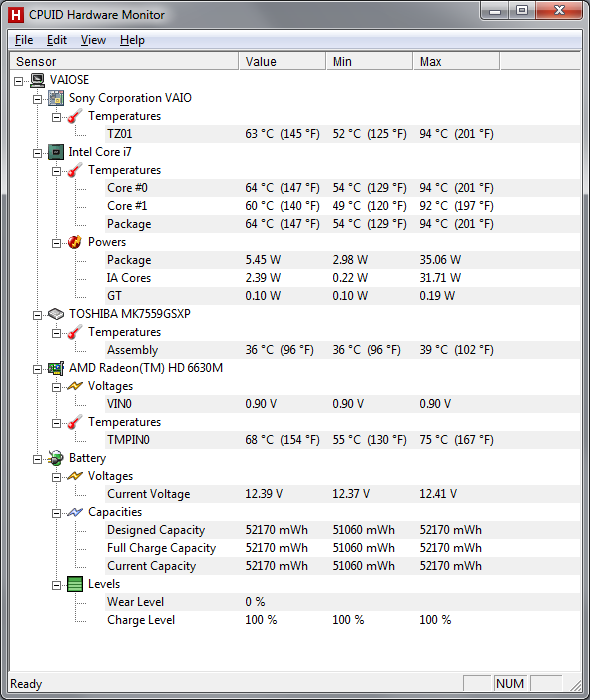
We’ve seen a few laptops run hotter than the VAIO SE under load—notably, the Toshiba Portege R835 ultraportable we just reviewed hits 100C on one of the cores during our stress tests—but 94C is still far more than we’d like. For an i7-2640M, this is the second laptop that might simply be “too thin” (the first being the Razer Blade that hit 95C). We’d really like to see max CPU thermals under 80C, even for thinner laptop designs. Long-term, the concern is that once you start to get some dust inside the fan and radiator, cooling performance will suffer and you’ll start to hit 100C or more. I recently saw this exact issue with a friend’s laptop (with an older Core 2 Duo T9550 CPU), which caused the laptop to get very hot to the touch and eventually shut off (with no warning) after heavy use.
Noise Levels
The high temperatures unfortunately have a secondary companion: noise pollution. At idle and under light loads, the VAIO SE is well behaved: we measured 31.2 dB from around 18” above and in front of the laptop (where your head would typically be if you’re using the laptop), and for many tasks the noise levels never broke 35 dB. All that starts to change when you put a heavy load on the system. For gaming, it really depends on the type of game you’re playing—specifically, how CPU intensive the game happens to be. 3DMark06 for instance never got about 36 dB in the graphics tests, but it tends to be pretty light on the CPU side of the fence. Batman: Arkham City and several other modern titles (Battlefield 3 and Skyrim) are a different story, with fan speeds apparently maxed out and noise levels hitting 46.7 dB—very similar to the Razer Blade, though I’d characterize the noise as being less annoying on the VAIO SE. The real culprit here is the CPU, though, as any heavy CPU load (video encoding, Cinebench, etc.) will peg the fan speed and noise at the same 46.7 dB.
For all the noise the fan generates, it doesn’t feel like it’s moving a lot of air, and this is where the hinge and the blocked exhaust port really makes its mark. It’s about what you’d get from other laptops if you stuck your hand in front of the exhaust and left it there. Provided you’re not planning on doing a lot of CPU intensive tasks, however, the VAIO SE isn’t all that noisy. For office applications and Internet browsing, I never had issues with the fan, and assuming you have a desktop to do your heavy lifting (e.g. video transcoding), gaming is about the only time you’re apt to hit max fan speed for “mainstream” use.










59 Comments
View All Comments
Conficio - Wednesday, April 4, 2012 - link
I'm really concerned about the hinge issue that Anand reports especially in combination with blocking the exhaust.I see my current 2004 laptop die of heat issues and the hinge is really loose. I don't know if I want to go back to the same problems. The laptop before that died of hinge issues as well.
Also, why not offer this with an i3 and make the AMD Graphics optional. I really want to lower the entry price ~ $850 so I can swap the hard disk to external and replace it with an SSD internally. Then we are talking Sony!
Conficio - Wednesday, April 4, 2012 - link
Apologies, should read "... that Jarred reports ..."Guppy - Saturday, April 7, 2012 - link
Another issue with this particular type of design occurs when the thermal exhaust port is in the back of the notebook, and very close to the screen itself.With prolonged exposure, the hot exhaust can end up producing a discolored patch on the LCD. I have a Compaq with a rear exhaust port that experienced significant darkening on the adjacent patch of the screen, which became noticeable after perhaps 7-8 years of use -- so it's a slow process, but will eventually happen if you keep the notebook around long enough.
Hrel - Wednesday, April 4, 2012 - link
From the way all of you at Anandtech go on and on and ON AND ON about IPS displays I was expecting WAY WAY more. There are TN panels in your chart that out-score the IPS panel. AND IPS panels have more latency. I am thoroughly confused as to why you STILL insist IPS is the way to go. Viewing angles are better, fine, I get that. But on a laptop I don't even want good viewing angles, I prefer for other people to not be able to, or at least have a hard time, seeing what I'm doing.JarredWalton - Wednesday, April 4, 2012 - link
TN sucks for so many reasons, that any display that's not TN is almost certainly going to be better. Yes, a good TN panel can can deliver scores in an ideal setup that are better than a decent IPS panel (e.g. the VAIO SE LCD), but viewing angles REALLY matter for me on a laptop. As an example, I used an XPS 15 on a flight and because of the angle of the seat and laptop, I ended up needing to slouch down just to see the display properly. Sure, the display had theoretically better contrast and colors, but only if you're looking straight at the display.As for latency, IPS is fine and anyone going on and on about latency in a display isn't talking about a laptop. "Oh no, I have 5ms more latency on my IPS display...on a laptop running at 25 FPS and moderate detail settings!" Furthermore, this isn't a gaming laptop, so there's no real concern with a fractional increase in latency. The only displays I've ever really had issues with on latency are S-PVA, but no one is putting those in laptops.
Finally, if you're worried about privacy, IPS has wider viewing angles and that would be "bad", but TN panels have reasonable viewing angles from the left and right as well so you don't even get privacy with them. It's only above and below that get completely whacked out on TN, and with a laptop on your *lap*, you will often end up with the "viewing from above" issue. If you really want privacy, don't sit next to people and use your laptop, tablet, or even a smartphone! Good luck with that....
Incidentally, I've used computers with "privacy screens" before, and while it does make it very difficult for anyone other than the person sitting right in front of the display to see what you're doing, such screens also look like crap. While you might want privacy, I'd rather the person next to me be able to glance over and see what movie I'm watching (or what I'm typing if they've got really good eyes and don't mind being rude) while I can actually enjoy the movie/work from a variety of angles. You'd have to be accessing very sensitive information to think that someone is going to spy on you and read it. It's pretty easy to tell when someone is staring at your laptop unless you're totally oblivious to your surroundings. "Um, excuse me, sir, but you've been staring at my computer for the past five minutes. Please go away."
azntwboy - Thursday, April 5, 2012 - link
I took comparison shots of my own between the SE1, SA2, HTC desire, and HP monitor. there is no red at all on this screen. I can't even see the difference when viewing these photos on the SE. I have to look at them on my HTC. the violets do not show, and there is a yellow tint to everything. to reduce the yellow, I set in Intel graphics properties a hue shift of +8 and blue gamma to 1.2. HP reportedly will fix this problem but haven't said how yet. Sony won't tell me anything about it.http://i41.tinypic.com/2zhpp8w.jpg
http://i40.tinypic.com/9a5t0m.jpg
http://i39.tinypic.com/58hoo.jpg
http://i44.tinypic.com/5ko9y0.jpg
http://i42.tinypic.com/maueco.jpg
the SE also has a problem with the headphone jack. it will not work with headsets with microphones unless the plug sits inconveniently halfway out or the call answer button on the microphone is depressed. its odd because none of the older vaio I tested today in the Sony shop have this problem. I emailed Sony but they deny this problem exists. my vpcse13fx and the vpcse15gb in the shop both had this issue. someone on notebook review says he has this also on his se1. I wonder if its been fixed on the se2?
also note that se and sa have sata3 disabled on BIOS newer than r1031h4. you'll be stuck with sata2 unless you flash to the old BIOS.
Guppy - Saturday, April 7, 2012 - link
>>"the SE also has a problem with the headphone jack. it will not work with headsets with microphones unless the plug sits inconveniently halfway out"This exact behavior can happen in certain cases where there are certain kinds of damage to your headphone's wiring (or the jack itself), I fixed an identical issue with my friend's laptop just recently (in his case, the defect was in the headphone wiring)
By hanging the plug partway out, you change where the segments of the plug make contact with their contacts -- I would recommend checking out the headphones and jack with a continuity tester for shorts and open pathways.
azntwboy - Thursday, April 5, 2012 - link
One other issue I have with the SE is the placement of the usb ports. They're too close together and I can't attach multiple usb drives because they're too wide for the too closely spaced ports. They're also inconveniently located on the right side where cables get in the way of my mouse.I'm also getting a buzzing sound on my right speaker. It's only 2 days old.
I was trying to decide between the sa and se but I decided on the se. The se has much better viewing angles and contrast but had bad color problems and Is a bit big for traveling. The SA is the perfect size but the viewing angles are horrendous and colors are washed out. I think the perfect laptop would be the SA with a screen from the Z2. With both the SA and SE you can install your own drives, expand the RAM, and swap the odd with a hdd caddy.
The red problem is very disconcerting.
thebumblebee - Thursday, April 5, 2012 - link
I got the Lenovo X220 with IPS display and i5 CPU (2.4 GHz) and 4GB Ram under a grand last June and nowadays you can buy it for even cheaper.yaxattax - Saturday, April 7, 2012 - link
I've got the SE and I installed Linux onto it. The first thing I have to say is that I don't use the switchable graphics, I run from the IGP all the time - as a result, I was led to believe the Stamina/Speed swwitch would be useless. This is not correct, and I discovered that the Speed/Stamina switch does something to change the thermal budget, as throttling will occur while the laptop is in Stamina mode, but it goes away as soon as the switch is moved to the Speed position. I don't know if this switch is changing thermal budget via BIOS (by being some kind of interface to motherboard jumpers), or if Linux has a driver to perform this based on the switch, but I observed the same behaviour in Windows.Second of all, two finger scrolling. Two finger scolling works just fine in Linux, which means that the drivers for windows are not very good. This is probably a result of the base hardware in the touchpad already having support in Linux.
I did as recommended in this review, and performed memory and SSD upgrades by hand, as it was cheaper. I took a gamble with the memory, hoping to be able to replace two SO-DIMMS, but I found out the hard way that 4GB is soldered in, which is a shame as I wanted to fit 16GB in, but 12GB is reasonable.
I love the display, the viewing angles are fantastic and I'm not finding myself distracted by contrast shifts, which was the main reason for my choosing of this model.